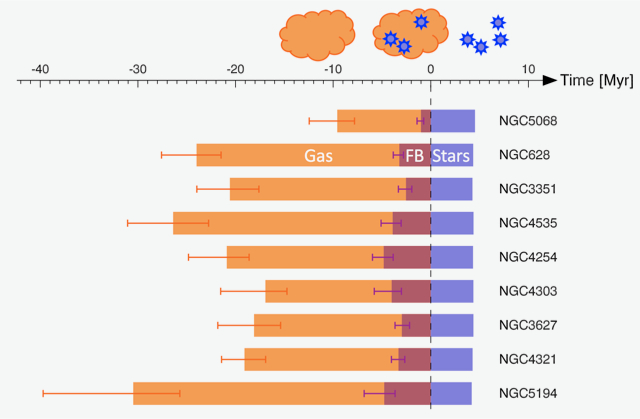| EPoS Contribution |
|
The lifecycle of molecular clouds in nearby star-forming disc galaxies
Melanie Chevance ARI/ZAH, Heidelberg, DE | |
| Deriving a theory of how galaxies turn their gas into stars on the cloud scale, as a function of the galactic environment, remains a major challenge. Star formation in galaxies is expected to be highly dependent on the galactic structure and dynamics, because it results from a competition between mechanisms such as gravitational collapse, shear, spiral arm passages, cloud-cloud collisions, and feedback. A statistically representative sample of galaxies is therefore needed to probe the wide range of conditions under which stars form. I will present the first systematic characterisation of the evolutionary timeline of the giant molecular cloud (GMC) lifecycle, star-formation and feedback, in homogeneous ALMA + optical observations at 50-100 pc resolution of a large sample of star-forming disc galaxies, obtained in the context of the PHANGS collaboration. I will show that GMC lifetimes are short (10-30 Myr), and exhibit environmental variation: at high molecular gas surface densities, they correlate with the time-scales for the aforementioned galactic dynamical processes, whereas at low gas surface densities GMCs decouple from galactic dynamics and live for an internal dynamical time-scale. In all studied environments, GMCs are dispersed after about one dynamical timescale by efficient stellar feedback, some 1 to 5 Myr after massive stars emerge, due to early feedback from radiation and stellar winds, prior to supernova explosions. This limits the integrated star formation efficiencies of GMCs to 4 to 10 per cent. Our findings reveal that star formation in galaxies is fast and inefficient, and is governed by cloud-scale, environmentally-dependent, dynamical processes, driving a rapid evolutionary cycling between GMCs and HII regions. | |
 | |
| Caption: Evolutionary timeline of molecular clouds, star formation, and feedback. Orange indicates the inert cloud phase, when only CO emission is visible and Halpha emission is absent. Purple indicates the young, gas-free, stellar phase when only Halpha emission is visible, and maroon indicates the feedback phase, when the region emits both in CO and Halpha. | |
| Collaborators: D. Kruijssen, ARI/ZAH, DE A. Hygate, MPIA, DE A. Schruba, MPE, DE S. Longmore, LJMU, UK |
Key publication
Suggested Session: Galactic Dynamics |

